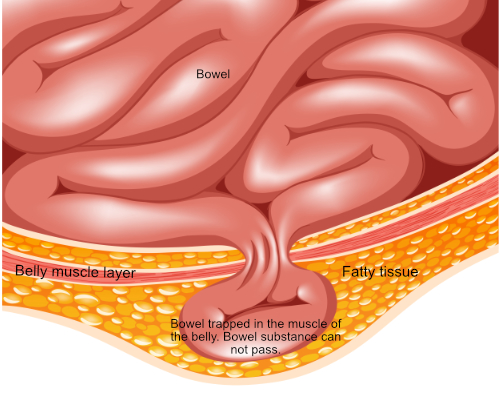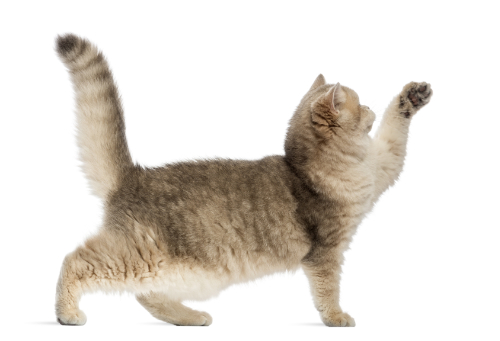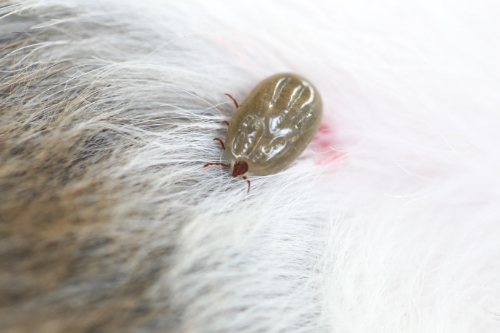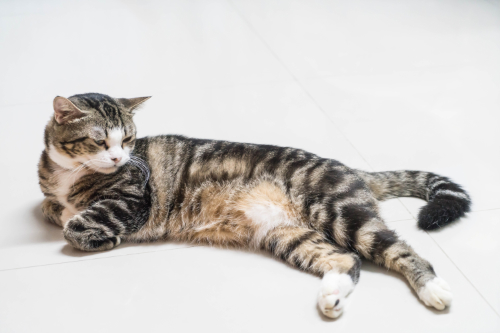When is there a lump on your cat's belly?
As you may know, lumps come in all shapes and sizes. Also in a cat. We say that something is a lump on your cat’s belly when the skin surface does not continue in a straight line, but shows a bulge. This bulge can arise in the muscle layers under the skin, in any tendons present under the skin, in fat tissue or in the skin layer itself. Depending on which tissue the lump originates from, we give different names to the lump on your cat’s belly. Below we explain the different lumps.
Umbilical hernia as the cause of a lump on your cat's belly
what is an umbilical hernia
In kittens, the muscle layer at the place where their belly button is, may not have closed properly after birth. At the location of the belly button, blood vessels pass through the belly button during growth in the uterus. These blood vessels run from the kitten’s liver to the placenta in the mother’s uterus. After a kitten is born, these blood vessels should disappear and the abdominal wall should no longer hold an opening. It should close up. In some cases, the abdominal wall (= muscle layer of the abdomen) does not close sufficiently. In this case, contents that should be in the abdominal cavity can get through the hole in the muscle layer under the skin.
how do you recognize an umbilical hernia
You will then see a small or larger lump exactly in the midline of the abdomen, just behind the point where the sternum ends. The lump usually feels very soft because in most cases it is just fat tissue that ends up under the skin from the abdominal cavity. Your kitten also shows no signs of illness, pain or anything like that.
When is an umbilical hernia dangerous?
In some rarer cases, the hole in the muscle layer of the abdomen can be so large that even an entire intestine can get into it. At this point, unfortunately, it has become a life-threatening situation. After all, the contents of the intestines cannot move any further because the intestine is pinched in that hole. The intestines are first damaged and your kitten has considerable abdominal pain. In addition, the lump feels hard and painful for your cat. At that moment, urgent is required and the kitten will have to be operated on immediately to free the intestine. Otherwise he will die.

Check by a vet
However, an umbilical hernia rarely requires surgery. But it is important that a vet assesses the size of the hole in the abdominal wall to estimate the risk of intestinal obstruction. Most holes are only 2-3mm in size and then it is not necessary to operate.
In cats that are spayed, we can solve the umbilical hernia at the same time as we neuter them. In the case of a male cat, it depends on whether an owner wants this, but during a castration he will be under anaesthesia and it can be decided to also remove the umbilical hernia at the same time. With a castration we normally do not have to open the abdominal wall and so we make an extra wound. This is not the case with the neutering of a female cat. There we already make a wound almost at the location of the umbilical hernia and it is therefore less stressful for a cat.
Body fat as a lump on the abdomen
Very often people come to their vet for a consultation to ask why their cat has a lump hanging under its belly. This is especially true for young cats around one year of age. And they’ve never seen any sign of pain, irritation, or discomfort from this lump. In almost all cases, this concerns an overweight cat. When a cat starts to get too fat, it usually starts on the abdominal wall between the hind legs. You can see the skin hanging there.

Most people say it started after spaying or neutering. In itself that is also a bit true, but the operation itself is not the cause. As a result of the spaying or neutering, a cat has gained a more efficient digestive system. He needs fewer calories during the day as a result of spaying or neutering. However, if you continue to give the same amount of food, he will eventually get fatter. And that starts with such a hanging potbelly.
It goes without saying that you do not have to have it removed surgically. However, it is important to give your cat less food or to switch to a food that contains few calories. Weight management food, for example, contain less energy and are therefore more suitable for your cat in this case.
A Lipoma in a cat
We don’t see a lipoma on a cat’s belly very often. It is a benign proliferation of fat cells. A benign tumor (see below). These kinds of lumps are very round and clearly delineated at the edge, in contrast to, for example, a potbelly. They do feel very soft and are not painful. The skin growing over the lump also looks normal.
If you think your cat has a lipoma, you can have this diagnosed by your vet. He or she will poke the lump with a needle and take out some tissue. He or she can then assess this tissue under the microscope. As long as a lipoma does not hinder your cat’s movement, it is not necessary to have this lump surgically removed. It’ss not beautiful to the eye, but a lipoma doesn’t do any harm to your cat.
A tick
In fact, of course, a tick is not a lump on your cat’s belly. Still, many people come to their vet asking what that lump on their cat’s belly is that they feel. Upon closer inspection, it turns out to be a tick. So take a good look at the lump yourself and rule out whether it cannot be a tick. You can usually recognize the tick by the fact that it is stuck in the skin on one side and that a few legs are visible on that side if you look closely.

An abscess on a cat's abdomen
If your cat has been in a fight, a bacteria may have gotten under its skin during a scratch or bite from another cat. His body will attack that bacteria with the help of pus cells. There will be a lot of pus cells in that place where the bacteria are. This assembly forms a pus-filled cavity under the skin. After a day or 2-3, this lump bursts open and all the pus comes out. But before that time you will only see a lump on your cat’s belly.
This lump is very painful for your cat and sometimes you can see a small wound in the middle. Often they also behave a little ill or do not want to eat well. In many cases, a cat with an abscess on its abdomen will also have a fever. You can measure his temperature with a normal rectal thermometer for humans. The temperature should be between 100.5°F and 102.5°F (38.1°C and 39.2°C)
If you think your cat has an abscess you should best go to your vet in order to get an antibiotica treatment. But cat’s also heal themselves often in case of an abscess. Once the abscess has bursted open it will heal by itself in most cases. But it wil heal sooner with some antibiotics.
A lump on your cat's abdomen due to inflammation
Inflammation is caused by damage to part of your cat’s abdominal skin. This damage must be repaired by the body. This causes an inflammatory response. It is a painful swelling often accompanied by redness of the skin. An inflammation is different from an abscess. In case of an abscess, a wound infection has also occurred. In the case of inflammation, a bacterial or viral infection does not always have to have occurred. However, there is always an inflammatory reaction when there is an abscess.
Inflammation as the cause of the lump on your cat’s belly does not necessarily need to be treated if it doesn’t seem to bother your cat too much. However, it should not get worse and should clearly improve within a day or 3 to 4. In any case, your cat should not have a fever and should continue to eat. Inflammation usually resolves on its own.
A cyst as a lump on your cat's abdomen
A cyst forms when fluid builds up in a cavity under the skin. This is not very common in cats. It feels like a nicely rounded lump that isn’t painful. They are not very soft, but not very hard either. It develops quite gradually over a period of months. In principle, a cyst does not need to be treated unless it gets in the way mechanically. They usually don’t get bigger than an inch or two. As a vet, we can aspirate them with a syringe with a needle, but they almost always come back within a month. Therefore, it is better to have the entire cyst, including the connective tissue wall of the cyst, surgically removed by your vet. After that the problem does not come back.

Benign and malignant tumors on the abdomen in your cat
What is a tumor?
All cells in the body are capable of multiplying. At a certain point, however, that mechanism is stopped per cell if it is no longer needed. For example, intestinal cells still have to multiply very often, but fat cells much less. If for some reason inhibiting the multiplication is no longer possible, cells will multiply uncontrollably. Then they form an accumulation of cells that are not actually needed.
On the belly, we see this mainly as a lump on your cat’s belly. It grows slowly over a period of months or very quickly over a period of weeks. They can have bald skin or be hairy. The more malignant the tumor is, the more the lump can eventually look like an open wound. This will get infected, making it very dirty and look awful. That’s because malignant tumors tend to grow through healthy tissue and extend beyond the skin.
Difference Between Benign and Malignant
We speak of benign tumors when they only grow and push away surrounding tissues. Malignant tumors (also known as cancer) grow through healthy tissue and destroy it in the process. Cells can also detach from the tumor and be spread throughout the body with the blood or lymphatic system. Subsequently, malignant tumors also arise in those other places, with all the consequences that entails.
Treatment of tumors
The moment a lump is visible, we do not yet know whether it is malignant or benign. Your vet can determine this in the skin by taking some cells with a needle and sending them for examination. If there is a benign tumor, it is usually sufficient to remove the tumor surgically. In the case of malignant tumours, we first check whether metastases are already visible. This is done with X-rays or ultrasound. If this is not the case, surgery is often possible. If there are already metastases, it is often very difficult to treat a cat and you end up with chemotherapy and radiation.
However, many cat owners do not want to do this and will eventually opt for euthanasia as soon as their cat no longer has a good quality of life. Since many malignant tumors spread to the lungs, they become out of breath at some point. Either they metastasise to the liver and the liver can no longer do its job. Cats with cancer also usually have a considerable weight loss because the cancer consumes a lot of energy.
Did you find your answer?
We hope you have found the answer to the question what the lump on your cat’s belly is. Good luck for the both of you in resolving it if necessary.


